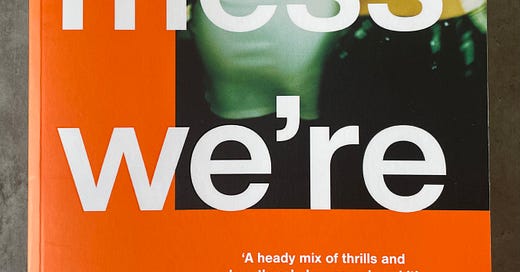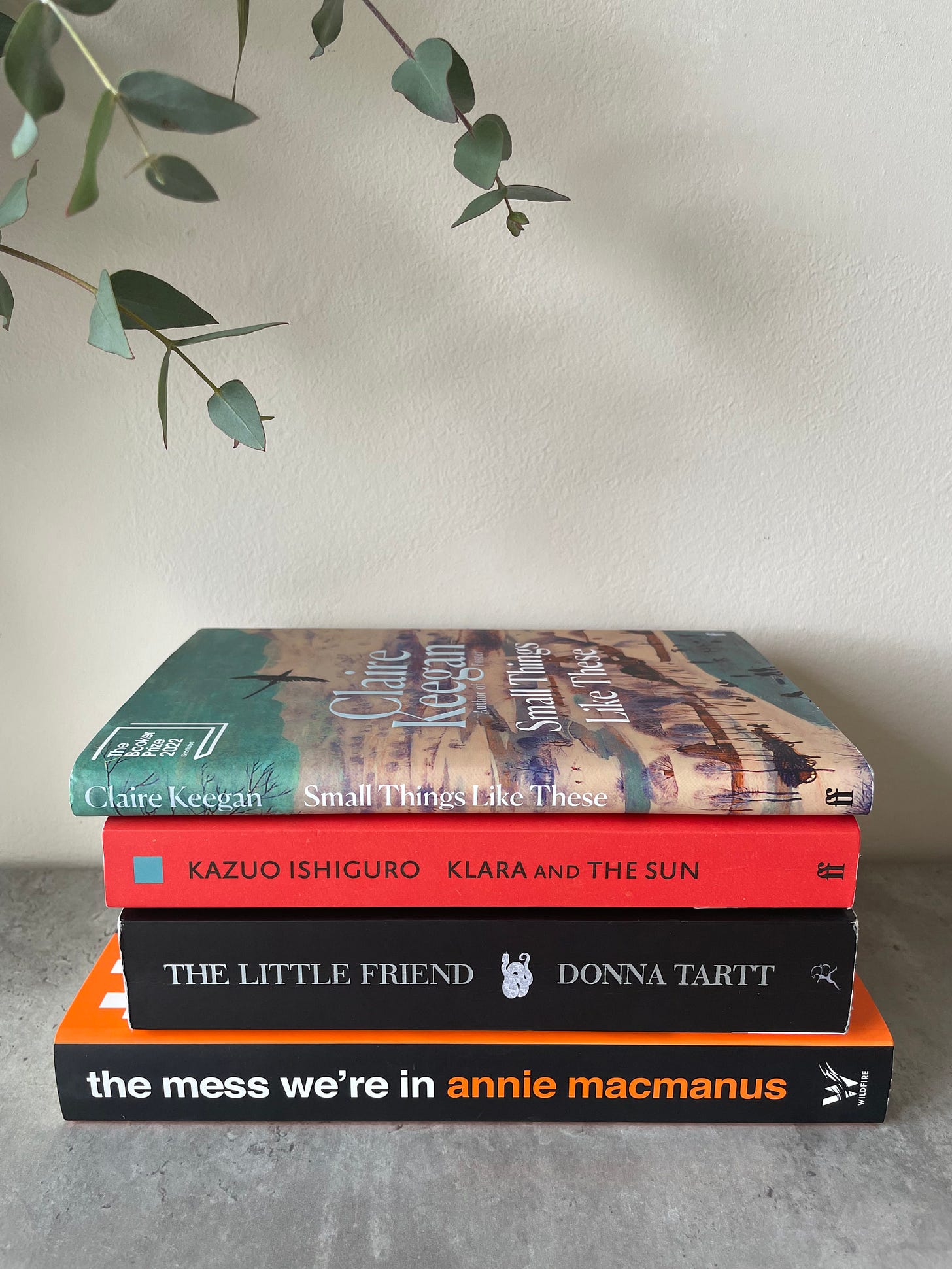Small Things Like These
Claire Keegan
My mum received this book as a gift whilst recovering from an operation last year. When I saw the snowy scene on the cover, I thought, “That’s nice, a little book about the small moments of joy that happen every day, like the smell of chipper or the sound of a baby’s giggle. Lovely now.”
I was so wrong to have made such an assumption. Also, I only wanted to read Small Things Like These to get it out of the way before seeing the film adaptation with Cillian Murphy (which is still TBC for a release date). It was a book to tick off before seeing the movie rather than something I actually wanted to read.
Looking back now, and considering how compelling the book was overall, I’m embarrassed to admit my initial ~flippancy~ towards it.
Small Things Like These is set in 1985 in New Ross, Co. Wexford and follows Bill Furlong, a coal merchant and father of five. It’s a dark and dreary winter, both literally and figuratively. The Catholic church is very much in power, people are upping sticks daily to find work in England, and it’s so baltic that you can almost feel the chill escaping from the pages.
This book lived in my brain for weeks afterwards, mainly because of how it’s written rather than the poignant storyline. Every sentence is considered, every word is precious, as if Claire Keegan was working with an extremely limited word count (maybe she was?).
I was quite curious about her approach, so I went down a Keegan-shaped rabbit hole, reading every article I could find about her. It turns out that, yes, she does write “economically” and says, “Elegance is saying just enough.”
Here’s an example of such Elegance with a capital E. There’s one bit where Furlong is in an orchard and considers robbing a “freckled pear.” I have never read a more stunning description of a pear. There’s another scene involving a “flock of wicked geese.” Wicked geese! I can see them now, squawking around the place, eyes bulging. Shivers.
After I read the book, I read it again a few days later. Claire Keegan’s choice of words, the structure of every sentence, and her chilling descriptions of New Ross, like the herd of abandoned cows “bawling to be milked”, amongst many other glimpses of the town and its inhabitants, shook me. I’m still shook.
🍊🍊🍊🍊🍊/5
The Little Friend
Donna Tartt
I didn’t know what the hell was going on for most of this book, but I got through it anyway. It’s very different from Donna Tartt’s previous bestsellers, The Secret History (slippery, disturbing, skin-crawly) and The Goldfinch (trippy, seedy, hormonal).
The Little Friend is set in a sleepy town in Mississippi in the 70s. The protagonist is a precocious 12-year-old called Harriet Cleve Dufresnes (only Donna Tartt could come up with a name like that). Most of the story centres on Harriet’s plan to avenge the person who killed her brother, Robin, who was mysteriously murdered when Harriet was a baby. But the story also conveys how the murder affected her family for many years to come.
There are a lot of characters in the book, so I got lost at times; Who’s Farish? Which one is Edie — one of the aunts or the granny? What about that Reverend person? What is going on!!!!!
So many goosepimple scenes though, especially in the last quarter. I couldn’t get them out of my head. And the descriptions are simple but create a tangible atmosphere: the “dust motes” swirling around Harriet’s house, the permanent smell of Ponds Cold Cream on her mother and the “dingy, shut-up vapor of neglect” that hangs over the backyard. Unlike Claire Keegan, Donna Tartt is not economical with her language — this book is a chonker at 576 pages (for context, that’s more than Prince [?] Harry’s thesis-thick memoir Spare).
But still, you really get sucked into this hazy town and all its snakes in the shadows. It was a mission to read at times, especially when feeling a leeeetle tired, but it was worth it to reach the end and complete a more challenging book from Donna Tarrt’s wild imagination. I spent hours on Reddit afterwards reading what others thought of the book and, in particular, that ending. Reddit for days. Much procrastinating.
🍊🍊🍊🍊/5
Klara and The Sun
Kazuo Ishiguro
Shoutout to Someone Sunny for recommending this book. I’d never heard of Kazuo Ishiguro before. Would you believe he’s an award-winning, celebrated, renowned and big-deal author? 🫠 Also, there’ll be a film version of Klara and the Sun, so I recommend reading the book first, if possiblé.
Ishiguro writes the story from Klara’s point of view. She’s an Artificial Friend i.e. a robot, who survives on “nourishment” from the sun. The book begins in the store where she’s for sale, waiting for a parent to purchase her for their child, which seems to be the norm in this weird world conjured by Ishiguro…and you’ll have to read the rest.
Like The Little Friend, I wasn’t sure what was going on in this book, but only in some parts. What’s the RPO building? What’s wrong with Josie? What does it mean when a person is “lifted”? Can someone explain please!!!
That’s the beauty of it, though. The book alludes to things, so you have to come up with your own ideas about what’s really happening.
As well as the descriptions of dystopia (which we are all heading towards IRL, I feel), Klara’s cute observations lived in my head for ages. There’s “Coffee Cup Lady”, whom Klara christens because “from the back, and in her thick wool coat, she seemed small and wide and round-shouldered like the ceramic coffee cups on the red shelves...” There are loads more cute observations like that throughout the book.
After finishing it, I disappeared into the Reddit vortex again, desperate (lol) to know how other readers interpreted the ending. That sparked a whole new spiral of thoughts, so I might read it again because it was a bit of a task at times and mostly depended on how fried or fresh I was to fully absorb and appreciate the writing. It’s still a V good book though.
🍊🍊🍊🍊/5
The Mess We’re In
Annie Macmanus
A fangirl for over a decade now, I love Annie Mac as a DJ and Annie Macmanus as a writer. She’s an icon, a legend, a total inspiration. How does she do it? The DJing, the Before Midnight-ing, the touring, the podcasting, the writing, the sea-swimming? She’s just bloomin’ brilliant.
I flew through her debut novel Mother Mother which came out in 2021. I’ll probably write about that one in a different listicle.
You’d fly through The Mess We’re In too. It’s an easy read but a high-quality easy read, if you get me. You could read it on the train, on the plane, walking the cat, anywhere, really. Not like The Little Friend, which allowed for no external distractions, and required full brain cell usage.
The Mess We’re In is set in London in 2000. The main character, Orla, has just moved to a squalid house in Kilburn with her brother, his bandmates, and her best friend, Neema. Orla’s 21, working two jobs and going out on the sesh every night. That’s all I’m sayin’.
Very early in the book, there’s a description of an Afters situation. Orla wakes up in the morning, slumped against a radiator in someone’s living room, hungover and scagged to BITS.
“The record spins on a deck in the corner. The coffee table is covered; overflowing ash trays, empty beer cans, half-full glasses with cigarette butts floating in the liquid like tiny dead bodies. A semi circle of space on the side nearest the sofa holds a row of messily chopped lines of cocaine.”
If you have even the faintest interest in dance music, it’s likely you’ve seen at least one of the dregs above, maybe in a club, a kitchen, a portaloo or anywhere with a pair of CDJs or Technics within sneezing distance. That scaggy scene alone still lives in my head. I’ve seen it with my own eyes more than times I’d like to. 🥲
Much like the author herself, the cover is iconic. It’s cool and fun and orange; everything you’d expect from Annie Mac. J’obsessed.
🍊🍊🍊🍊🍊/5






